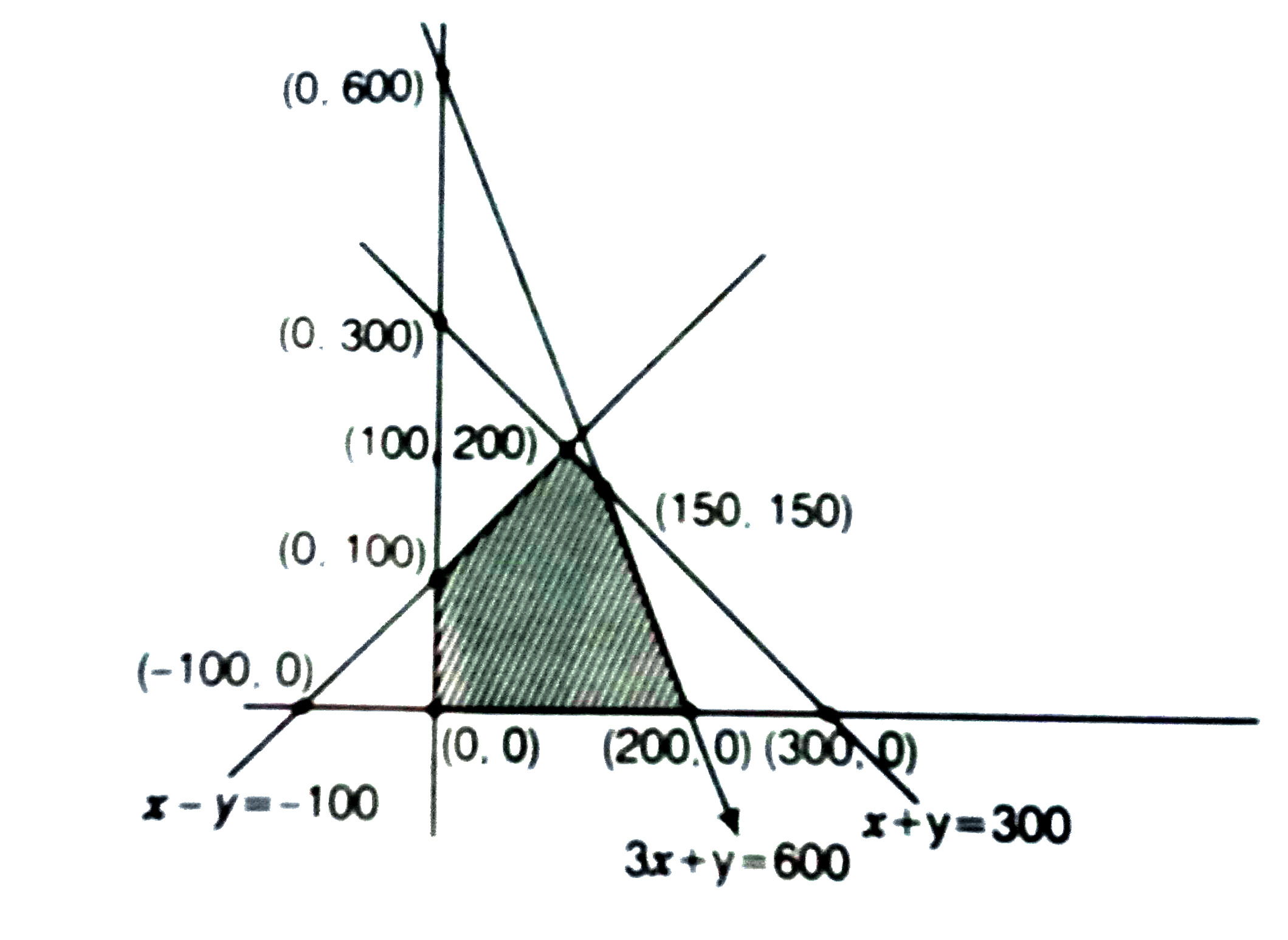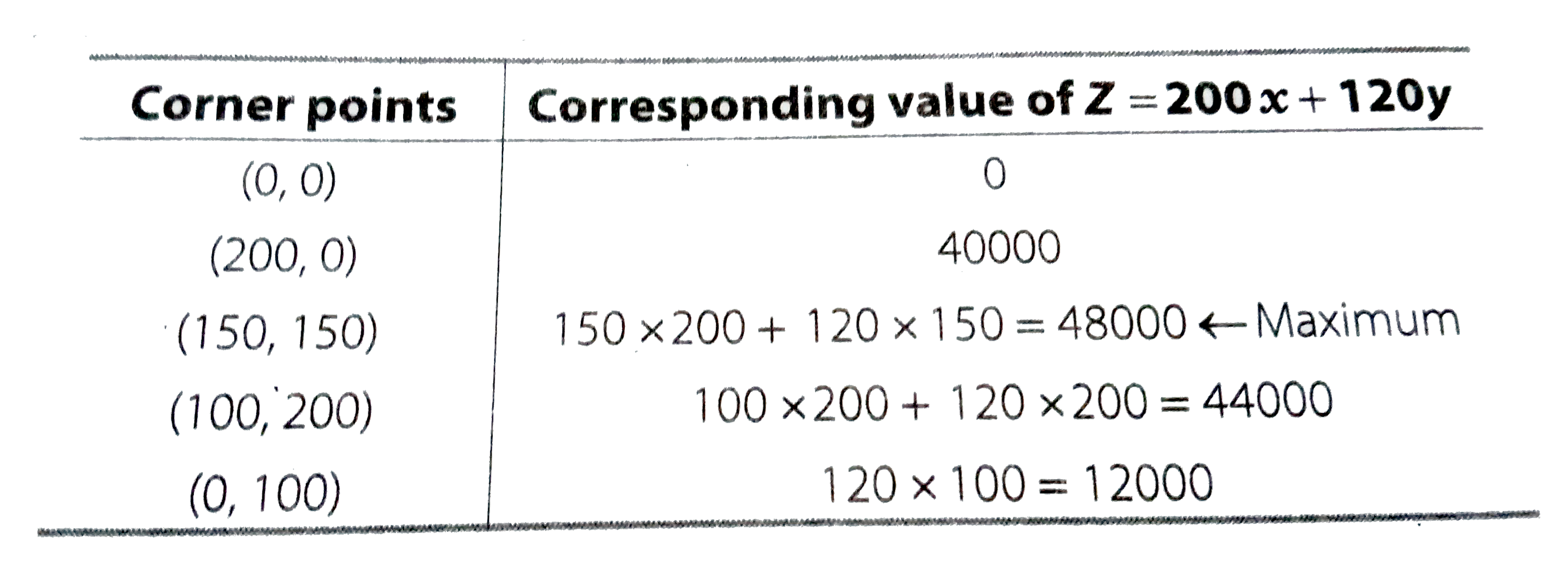InterviewSolution
This section includes InterviewSolutions, each offering curated multiple-choice questions to sharpen your knowledge and support exam preparation. Choose a topic below to get started.
| 2802. |
((costheta+isintheta)^5(cos3theta-isin3theta)^6)/((cos2theta+isin2theta)^3(cos4theta-isin4theta)^5)= |
| Answer» Answer :B | |
| 2803. |
Show that if R is an equivalence relation on X then dom R=rngR =X. |
|
Answer» Solution :LET R is an EQUIVALENCE RELATION on X . `implies R "is REFLEXIVE"` `implies(x,x)in R AA x in X ` `implies "Dom" R="Rng" R=X` |
|
| 2804. |
Let phi(x)=(x)/(x^(2)+1)(x+1) if a, band c are the roots of the equation x^(3) -3x+lambda=0(lambda ne 0) Then phi(a)phi(b)phi(c ) = |
|
Answer» `LAMBDA` |
|
| 2805. |
Refers to question 14. How many sweaters of each type of should the company make in an day to get a maximum profit? What is the maximum profit? |
|
Answer» On solving x+y=300 and 3x+y=600 we get x=150, y=150 On solving x-y=100 and x+y=300 we get x=100, y=200  From the SHADED FEASIBLE region it is CLEAR that corrdingates of corner points are (0,0),(200,0),(150,150),(100,200), and (0,100)  Hence 150 sweaters of each type made by company and MAXIMUM profit=48000. |
|
| 2806. |
intsqrt((a-x)/(a+x))dx=....+c |
|
Answer» `(a)/(2)SIN^(-1)((X)/(a))-sqrt(a^(2)-x^(2))` |
|
| 2807. |
Find the area bounded by the curves y = log_(2) x and x = 2 y - y^(2) and the lines y = 0, y = 2 |
|
Answer» |
|
| 2808. |
Consider the function f(x)cosx^2. Then |
|
Answer» f is of PERIOD `2pi` |
|
| 2809. |
Rewrite the following sets by the set builder method. (i) {1,3,5,7,9}, (ii){(1)/(9),(1)/(25),(1)/(49),(1)/(81)}. |
|
Answer» |
|
| 2810. |
int(tan(x-theta)tan(x+theta)tan2xdx |
|
Answer» |
|
| 2811. |
One root of the equation (12x -1)(6x -1)(4x-1)(3x-1)=5 is |
| Answer» ANSWER :D | |
| 2812. |
Find derivatives of the following functions(e^(sin x) - a^(cos x)) |
|
Answer» SOLUTION :`y = E^(SIN X)- a^ (COS x) dy/dx = d/dx(e^(sin x))-d/dx(a^(cos x) = e^(sin x).d/dx(sin x) - a^(cos x). In a. d/dx(cos x) e^(sin x).cos x + a^(cos x). In a. sin x` |
|
| 2813. |
If (2,3,-3) is one end of a diameter of the sphere x^(2)+y^(2)+z^(2) - 6x - 12y - 2z +20 = 0then the other end of the diameteris |
|
Answer» `(4,9,-1)` |
|
| 2814. |
Given that the events E and F are such that P(E) = (1)/(2), P(E cup F) = (3)/(5) and P(F) = p. Find the p, if E and F are independent events. |
|
Answer» |
|
| 2815. |
From a the point P(h, k) three normals are drawn to the parabola x^2=8y and m_1m_2" and "m_3 are the slopes of three normals, if the two normals from P are such that they make complementary angles with the axis then the directrix of the locus of point P (conic) is : |
|
Answer» `2x-3=0` |
|
| 2817. |
Find the angle between two vectors a and b with magnitudes sqrt(3) and 2 respectively, having a.b=sqrt(6). |
|
Answer» |
|
| 2818. |
Let X denote the number of hours you study during a randomly selected school day. The probability that X can take the values x, has the following form, where k is some unknown constant. P(X=x)={{:(0.1,",",x=0),(kx,",","x=1 or 2"),(k(5-x),",","X=3 or 4 "),(0,",","otherwise"):} i. Find the value of k ii. What is the probability that you study atleast two hours? Exactly 2 hours? Atmost 2 hours? |
|
Answer» |
|
| 2819. |
Let P={(x,y)//x in R, y in R, x^(2)+y^(2)=1}, then P is |
|
Answer» REFLEXIVE |
|
| 2820. |
Sum to infininty of the series 1 + 4/5 + 7/5^(2) + 10/5^(3) + ...... is |
|
Answer» `16/35` |
|
| 2821. |
Find the order and the degree of the following differential equation (d^2y)/(dx^2) + 5x ((dy)/(dx))^2 - 6y = log x |
| Answer» SOLUTION :ORDER = 2, DEGREE = 1 | |
| 2822. |
Find a vector in the direction of vector veca=hati-2hatj that has magnitude7 units. |
|
Answer» |
|
| 2823. |
Evaluate the limit . underset(n to 00)("lim")(1)/(n) [tan (pi)/(4n) + tan (2pi)/(4n) +………..tan (npi)/(4n)] |
|
Answer» |
|
| 2824. |
Determine P(E|F) A dice is thrown three times, E : 4 appears on the third toss, F : 6 and 5 appears respectively on first two tosses |
|
Answer» |
|
| 2825. |
Integrate thefunction in Exercise. (x^(3) sin(tan^(-1)x^(4)))/(1+x^(8)) |
|
Answer» |
|
| 2826. |
If (2^(200)-2^(192).31+2^n) is the perfect square of a natural number , then find the sum of digits of 'n' . |
|
Answer» |
|
| 2827. |
If ""^(n)C_(r-1)=36 ,""^(n)C_(r)= 84 and ""^(n)C_(r+1)=126,then the value of ""^(n)C_(8) is |
|
Answer» 10 |
|
| 2828. |
Let g(x)=e^f(x)), g(x+1)=xg(x), then (g'((2n+1)/(2))g((1)/(2))-g'((1)/(2))g((2n+1)/(2)))/(g((2n+1)/(2))g((1)/(2))), where n in N, is |
|
Answer» `2 (1+(1)/(2)+(1)/(3)+….+(1)/(n))` |
|
| 2829. |
Prove that : int_(9)^(a) (dx)/(x+sqrt(a^(2)-x^(2)))=(pi)/(4) |
| Answer» | |
| 2830. |
Evaluate the following definite integrals as limit of sums : int_(1)^(2)3^(x)dx |
|
Answer» |
|
| 2831. |
Construct Collection of all the nationalised political parties in the form of set and describe it with the help of proposition. |
|
Answer» SOLUTION :C ={BJP, Congress, CPI, CPI (M), JU (U), JD(S),JP} |
|
| 2833. |
Prove that the circles x^(2) + y^(20 - 8x - 6y + 21 =0 and x^(2) + y^(2) - 2y - 15 = 0have exactly two common tangents. Also find the point of intersection of those tangents. |
|
Answer» |
|
| 2834. |
The pint of extremum of f(x)=int_0^x(t-2)^2(t-1)dtis a |
|
Answer» a)MAXIMUM at x=1 |
|
| 2835. |
int (1)/((x^(2) + 1)(x^(2)+ 4))dx = |
|
Answer» `(1)/(3) [ TAN^(-1) X - (1)/(2) tan^(-1)""(x)/(2)] + c` |
|
| 2836. |
Find derivatives of the following functions.sec^(-1)(2x+1) |
|
Answer» Solution :`y=sec^(-1)(2x+1)` `dy/DX=1/((2x+1)sqrt(2x+1)^2-1).d/dx(2x+1)` `[becaused/dx(sec^(-1)u)=1/(|u|sqrt(u^2-1)).(DU)/dx` `2/((2x+1)sqrt(4x^2+4x))=1/((2x+1)sqrt(x^2+x))` |
|
| 2837. |
If the line y = x cuts the curve x^(3) + 3y^(3) - 30xy + 72x - 55 = 0 in points A,B and C, then the value of(4sqrt(2))/(55) OA.OB.OC (where O is the origin), is |
| Answer» Answer :A | |
| 2838. |
Evaluate the following integrals: int_2^3 xdx/(x^2+1) |
|
Answer» Solution :`int_2^3 (X dx)/(x^2+1) = 1/2 int_2^3 (2X dx)/(x^2+1)` =`1/2[log|x^2+1|]_0^3` =`1/2[log10-log5]` `= 1/2 log ((10)5) = 1/2 LOG2` |
|
| 2839. |
thevalueof tan 40^@+ tan20^@+ sqrt(3) tan 20^@tan 40^@isequalto |
|
Answer» `SQRT(12)` |
|
| 2840. |
If lim_(x to 0) (2^(sin x^(2)) - 2^(tan x^2) - 2x^(7))/(x^n) exists finitely and equal to a non-zero number then n is |
|
Answer» 3 =`lim_(x to 0) ((2^(tan x^2)(2^(sin x^(2)tan x^2) -1))/(SINX^(2)-tanx^(2)) xx (sin x^(2) - tan x^(2))- 2x^(7))/(x^n)` =`lim_(x to 0) 1/(x^n)[(2^(tan x^2)(2^(sin x^(2)tan x^2) -1))/(sinx^(2)-tanx^(2)) ((x^(2) - (x^6)/(3 !) + (x^10)/(5!)....)-(x^(2) + (x^6)/3 + (2x^(10))/(15)+....))-2x^(7)]` `= lim_(x to 0) (x^6)/(x^n)[(2^(tan x^2)(2^(sin x^(2)tan x^2) -1))/((sinx^(2)-tanx^(2))) (-1/2 + "term containing"x)-2x^(1)]` `implies n = 6`. |
|
| 2841. |
If lim_(xto0)f(x)=l in R, then |
|
Answer» `lim_(xto0)F(X^(2))=L^(2)` |
|
| 2842. |
Evaluate the following integral : int(x+sqrt(a^(2)+x^(2)))^(2007)dx |
|
Answer» Solution :Let us substitute `x+SQRT(a^(2)+x^(2))=t` so that `sqrt(a^(2)+x^(2)-x=(a^(2))/(t)` `implies2x=t-(a^(2))/(t)` `impliesdx=(1)/(2)(1+(a^(2))/(t^(2)))DT` under given substitution, the given integral reduces to `int(x+sqrt(a^(2)+x^(2)))^(2007)dx=intt^(2007)*(1)/(2)(1+(a^(2))/(t^(2)))dt` `=(1)/(2)int(t^(2007)+a^(2)t^(2005))dt` `=(1)/(2)[(t^(2008))/(2008)+a^(2)*(t^(2006))/(2006)]+k` `=(1)/(2)(x+sqrt(a^(2)+x^(2)))^(2006)[((x+sqrt(a^(2)+x^(2)))^(2))/(2008)+(a^(2))/(2006)]+k` |
|
| 2843. |
Find derivatives of the following functions. In (sqrtx + 1) |
|
Answer» SOLUTION :`y = In (SQRT X + 1) dy/dx = d/dx in(sqrt x + 1)= 1/(sqrt x + 1).d/dx(sqrt x + 1) 1/(sqrt x + 1).1/(2sqrt x) = 1/{2(x + sqrt x)}` |
|
| 2844. |
If |a|=|b|=1 and |a+b|=sqrt(3), then the value of (3a-4b).(2a+5b) is |
|
Answer» `-21` `RARR""a*b=(3-1-1)/2=1/2"...(i)"[because|a|=|b|=1, "GIVEN"]` `:.""(3a-4b)*(2a+5b)=6|a|^2+15a*b-20|b|^2` `=6+7a*b-20` `=6+7/2-20"[from Eq. (i)]"` `=(7-28)/2-21/2` |
|
| 2845. |
Distance between the two planes : 2x + 3y + 4z = 4 and 4x + 6y + 8z = 12 is |
| Answer» Answer :D | |
| 2846. |
Fundamental theorem of definite integral : (d)/(dx)(F(x))=(e^(sinx))/(x),ngt0. If int_(1)^(4)(2e^(sinx^(2)))/(x)dx=F(k)-F(1) then the possible value of k is…….. |
|
Answer» 4 |
|
| 2847. |
int(cos4x+1)/(cosx-tanx)dx=k cos4 x+c then..... |
|
Answer» `k=-(1)/(2)` |
|
| 2848. |
int tan^(-1) (sqrt((1-x)/(1+x)))dx is equal to |
|
Answer» `1/2(x cos^(-1)x-sqrt(1-x^(2))+C)` |
|
| 2849. |
Let A(3, 7) and B(6, 5) are two points. C:x^(2)+y^(2)-4x-6y-3=0 is a circle. Q.Equation of the member of the family of circles S that bisects the circumference of C is : |
|
Answer» `X^(2)+y^(2)-5x-1=0` |
|
| 2850. |
Let ** be a binary operation on the set of natural numbers given by a**b = L.C.M of a and b, find 5**7, |
|
Answer» |
|